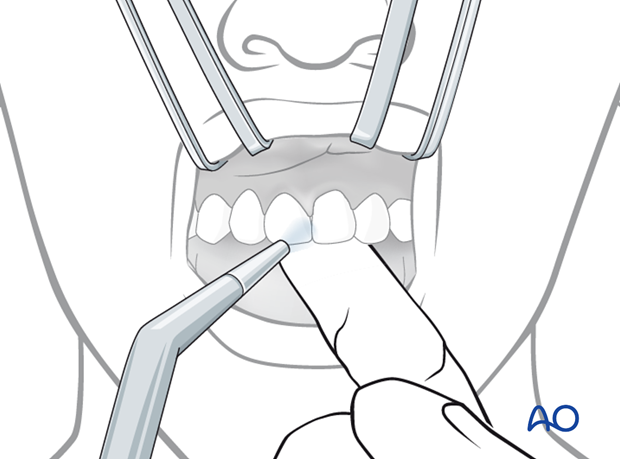Repositioning and fixation
1. Decision/Indication
The displaced tooth needs to be repositioned as soon as possible to normalize occlusion, to enable optimal pulpal healing, and to permit fast periodontal healing.
2. Repositioning
The exposed root surface of the displaced tooth is cleansed with saline solution before repositioning.

The tooth is then repositioned with light axial digital pressure until its normal position has been reestablished.

3. Fixation
Drying
Fixation is preferably accomplished with acid etch of the incisal enamel and application of a resin splint involving intact neighboring teeth. The teeth involved are gently dried with compressed air (as illustrated) or absolute alcohol and kept dry during the fixation procedure.
A finger on the lingual aspect of the tooth can maintain tooth position during the fixation procedure.

Etching
Points of fixation in the repositioned tooth as well as neighboring teeth are etched with phosphoric acid for 20 seconds.
Remember to place a suction tube to maintain dryness during etching procedure.

Cleansing
The etch gel is removed by saline irrigation. Make sure to direct the saline jet in a direction away from soft-tissue wounds and to place a suction tube to remove the spray of the saline and etch gel.
The fixation spots are then dried.
It is imperative that the enamel be kept dry until the resin has completely set.

Application of resin material
Resin material (eg, used for temporary crowns and bridges) is applied to provide a splint. This material allows a certain flexibility of the splint and is easy to remove.
In cases of a simple extrusion, fixation should be generally maintained for 2 weeks
Note: the patient should be put on soft diet for 2 weeks. Exposure to temperature extremes should be avoided.
Note: care has to be taken that there is no occlusal loading to the affected tooth.

Splint removal
After the fixation period (two weeks) the resin can be peeled off with a dental scaler or removed with a burr. The tooth must be supported by axial digital pressure during this procedure.

4. Aftercare following treatment of extrusion
Aftercare may include endodontic treatment. The decision for endodontic treatment may be taken after 2 to 6 months of follow-up if the tooth still does not respond to electrometric or thermal pulp testing and/or if x-rays show a periapical radiolucency or the crown becomes discolored.
Diet
Patients are encouraged to restrict themselves to a semi-solid diet and avoid clenching and any other traumatic overload to the traumatized tooth for a period of 1 or 2 weeks posttrauma.
Further treatment
Further dental treatment may be completed as an elective procedure in a dental office, for example management of discoloration, cosmetic correction, porcelain restoration, etc.













